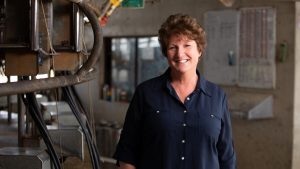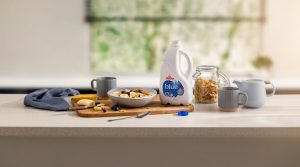
Standard three-litre and two-litre private label milk retails in Woolworths-owned Countdown supermarkets for $NZ5.27 and $NZ3.53 respectively, or about $NZ1.77 a litre.
At current exchange rates, that’s effectively $1.66/litre in Australian values.
Back on this side of the Tasman, Woolworths’ house brand Drought Relief range fetches just $3.59 and $2.39 (for three- and two-litre bottles) – or $1.20/litre.
Woolies’ corporate rivals Coles and Aldi also price their house brand fresh lines at $1.20/litre, and until a year ago refused to sell above the contentious $1/litre price point.
World’s cheapest milk
Dairy leaders calculate Australia’s supermarket branded fresh milk is now about the world’s cheapest, even notably behind major milk producer nations such as Ireland and Germany where discounted lines cost about $1/litre more.
Those deep discounts earnt local supermarkets more harsh rebukes last week from federal Agriculture Minister David Littleproud who lambasted retailers for devaluing farmers’ costly production efforts and restricting the flow of fair returns back to a rapidly shrinking pool of fresh milk market producers.
In particular, he was quick to blast Woolworths for a “tokenistic” commitment to keeping a 10c/ litre retail levy directed to farmers for another year, rather than lifting prices in its dairy cabinets to help the whole industry’s sustainability.
Coles has a similar dedicated 10c levy, which Mr Littleproud called “a gimmick duping consumers into thinking dairy farmers are getting genuine help from the supermarkets”.
Seeking $1.50/litre
Dairy farmers Australia-wide want generic milk prices lifted to at least $1.50/litre, which they say would just cover Australia’s cost of living rises since Coles went “down down” to set the dollar milk benchmark in 2011, undercutting its previous discount prices of $1.30 and $1.09/l.
They argue most consumers were already concerned about the plight of farmers who have battled savage feed, water and energy cost hikes over 10 years while milk has become even cheaper than it was at the start of last decade.
That suggests NZ supermarket prices are a pretty good indicator of what consumers are willing to pay
– Colin Thompson, NSW Farmers
Farmers noted NZ’s significantly higher milk prices suggested supermarket shoppers would pay more for milk, and retailers were actually comfortable charging more, if it was not treated as discount bait to draw foot traffic into stores.
In fact, three-litre bottled fresh milk in NZ typically costs up to $NZ6.89 ($A6.45) for major brands such as Goodman Fielder’s Meadow Fresh and Fonterra’s Anchor – about $1.50 more than Australian big brands Dairy Farmers or Pauls.
“The fresh milk market in NZ is a bit different to ours because it’s such a very small part of their total dairy production, but the supermarkets still decide how it’s priced, not the NZ milk processors or anybody else,” said NSW Farmers dairy committee chairman Colin Thompson.
“That suggests NZ supermarket prices are a pretty good indicator of what consumers are willing to pay.”
However, even in NZ farmers feel they don’t reap a great return from the deal, collecting an average of only NZ60 cents/litre from retail milk sales.
“At the end of the day it’s what the free market pays, but you do have to wonder if supermarkets generally have too much power,” said Federated Farmers of NZ vice president, Andrew Hoggard.
Consumer sympathy
NSW Farmers’ Mr Thompson said consumers in Australia seemed sympathetic to dairy farmers’ struggles and they valued locally fresh product and “want Australian farms to continue supplying their milk”.
However, NSW dairy farmer numbers had crashed from 1800 to 570 in 20 years and at this rate would be almost zero by 2030, while Queensland had just 300 and now imported half its fresh drinking milk.
We’re not talking re-regulation, but I wouldn’t rule out legislative changes
– Colin Thompson
Shoppers were naturally attracted to cheaper value and automatically responded when supermarkets deliberately cut prices and held them low, irrespective of inflationary costs being borne by farmers.
Low house brand prices had forced processors to keep their own milk brand prices low, too, in turn restricting farmgate payments to farmers which had driven many to quit or switch to beef or cropping.
Legislative changes?
“We definitely need a better payment arrangement back to farmers and there are some pretty serious options being discussed with the government,” he said.
“We’re not talking re-regulation, but I wouldn’t rule out legislative changes.”
It’s a fair question to ask why supermarkets here are not charging the sort of money for milk they sell it for in NZ
– Shaughan Morgan, Dairy Connect
Dairy Connect chief executive officer Shaughn Morgan agreed it “may be necessary for the federal government to take the bull by the horns and do something” to ensure prices paid by supermarket shoppers flowed down to dairy farms.
“It’s a fair question to ask why supermarkets here are not charging the sort of money for milk they sell it for in NZ,” he said.
“We need retailers to step up and take some leadership roles because at the end of the day the price is up to supermarkets.
“Dairy farmers can’t afford to be squeezed any further.”
If retailers wanted to keep their customer-dependent social licence to operate, they could not afford to use dairy farmers as cannon fodder.
“We were very pleased Woolworths broke the $1/litre milk price barrier last year, but we’ve got to ask why Australian prices are still at the bottom of the barrel on an international scale,” he said.
“This is by no means a win-win situation for all participants in the industry.”

























